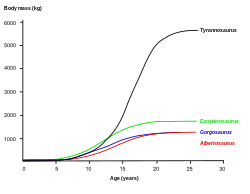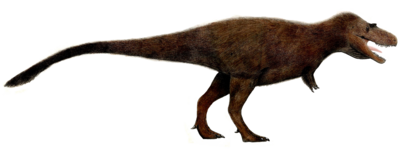Daspletosaurus torosus steveoc flipped
Autor:
Steveoc 86 na projektu Wikipedie v jazyce angličtina
Přisuzování:
Obrázek je označen jako „Vyžadováno uvedení zdroje“ (Attribution Required), ale nebyly uvedeny žádné informace o přiřazení. Při použití šablony MediaWiki pro licence CC-BY byl pravděpodobně parametr atribuce vynechán. Autoři zde mohou najít příklad pro správné použití šablon.
Shortlink:
Zdroj:
Formát:
1024 x 341 Pixel (142246 Bytes)
Popis:
Daspletosaurus torosus restoration,
- • Based proportionally on a Gregory Paul skeletal reconstruction in Tyrannosaurus Rex, the Tyrant King by Peter Larson and Kenneth Carpenter (2008).[1]
- • A few Skin impressions are known for tyrannosaurids which show lightly Pebbled (scaley) skin. The scales are small, averaging 2.4mm.[2] Skin impressions from the closley related Gorgosaurus are reported to show both smooth, naked skin and scales.[3][4]
- However, most coelurosaur fossils show feathers covering thier bodies and the smaller basal tyrannosauriod Dilong and the larger tyrannosauroid Yutyrannus also show feathers. This raises the probability that, derived tyrannosaurs had a mix of feathers and scales on different parts of the body or that feathers were lost as individuals reach maturity[5][6]
- • The muscles are based on a diagram by Scott Hartman [1] with some details from[7].
- • The colours and patterns, as with nearly all reconstructions of prehistoric creatures, are speculative.
References
- ↑ Paul, Gregory S. (2008) "The extreme lifestyles and habits of the gigantic tyrannosaurid superpredators of the Late Cretaceous of North America and Asia" in Tyrannosaurus rex, the Tyrant King (Life of the Past), Bloomington: Indiana University Press, p. 316 ISBN: 0-253-35087-5.
- ↑ Currie, Philip; Badamgarav, Demchig; Koppelhus, Eva. (2003). "'The First Late Cretaceous Footprints from the Nemegt Locality in the Gobi of Mongolia'" (PDF). Ichnos 10 (1): 1-13. Archived from the original on 2009-07-20. Retrieved on 2016-05-17.
- ↑ Currie, P. (2001). 2001 A. Watson Armour Symposium: The Paleobiology and Phylogenetics of Large Theropods. Field Museum of Natural History, Chicago.
- ↑ Carpenter, Kenneth (1997) "Tyrannosauridae" in Currie, Philip J. & Padian, Kevin (eds.). , ed. Encyclopedia of Dinosaurs, San Diego: Academic Press, pp. 768 ISBN: 0-12-226810-5.
- ↑ Xu, X., Norell, M. A., Kuang, X., Wang, X., Zhao, Q., Jia, C. (2004). "Basal tyrannosauroids from China and evidence for protofeathers in tyrannosauroids". Nature 431: 680–684. DOI:10.1038/nature02855.
- ↑ (2012). "A gigantic feathered dinosaur from the Lower Cretaceous of China" (PDF). Nature 484: 92–95. DOI:10.1038/nature10906. PMID 22481363.
- ↑ Persons, Scott; Currie, Philip. (2010). "'The Tail of Tyrannosaurus: Reassessing the Size and Locomotive Importance of the M. caudofemoralis in Non-Avian Theropods'". The Anatomical Record 294: 119-131.
Licence:
Credit:
Originally from File:Daspletosaurus torosus steveoc.jpg.
Relevantní obrázky
Relevantní články
TyrannosaurusTyrannosaurus byl jeden z největších masožravých dinosaurů (teropodů) a zároveň jedním z největších suchozemských predátorů všech dob. Přestože již v devadesátých letech 20. století ztratil primát největšího dravého dinosaura, svou tělesnou stavbou je dle posledních objevů stále nejmohutnějším a nejhmotnějším známým masožravým dinosaurem. Tyrannosaurus rex, formálně popsaný v roce 1905, je také jedním z nejpopulárnějších pravěkých živočichů vůbec. .. pokračovat ve čtení
















